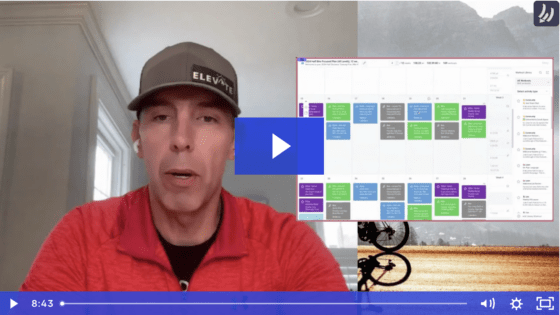
Many of us are parents, we are professionals, we are active in our communities, and we support our kids as they do athletics as well as all the activities they do. By the end of the day it is easy to see how the vast majority of your time is simply not “yours.” Yet we all know that getting better isn’t just limited to physical gifts or disposable cash — it’s really about finding a way to be successful given the constraints of our lives.
Your training and fitness are 100% affected by how you manage your life. Here are our top six tips to help you save time for your training.
Tip #1 — The first and most important tip is to plan your week.
Most of you have probably made an investment in some kind of training or training program. But simply knowing the workouts you want to do isn’t the same as actually getting them done. To accomplish that, your top priority should be to merge your workouts with your calendar.
I recommend sitting down every Sunday night, pulling out your training plan and lining it up next to your calendar. Then literally scheduling your workouts into your calendar as if they were meetings or appointments. This act will not only reinforce the fact that you’re going to do these workouts, it will also help you set expectations around what is really possible to achieve this week. For example when you pull out the calendar and see that Friday is full of meetings, you can plan ahead and either make a change to your training or understand that you’ll be lucky to get in one session.
Weekly planning also lets you stay on top of other schedules. Many of us are beholden to dynamically changing swim schedules. Swim team has started up, it’s the annual pool cleaning time, there’s a new session of classes at the Y, whatever the issue may be…you need to stay on top of the schedules in order to make sure you can get your workouts done. By sitting down and putting your workouts into your schedule you will effectively eliminate the mistake of showing up to the pool, or the gym, at the wrong time for your workout.
Whenever possible you can actually “double down.” That means you can try combine workouts for maximum impact. If having you take two showers after doing two workouts and then do all the laundry from two workouts…you are losing a huge chunk of time. If this is you, you should consider doubling down. So instead of biking now and running later, I can run now. Instead of swimming now and running later, I can swim and then run straight from the gym. Any opportunity you have to put those two workouts together not only increases the chances that the done, but it also frees up extra time schedule.
Finally I recommend that you regularly check the forecast. I have used some online apps to notify me if is there is going to be rain or snow the next day. I have set those up to send to my phone at 8 PM, this way I have plenty of time to adjust my workouts and prepare accordingly. Knowing the weather is a critical first step in making sure that your week is going to go plan.
Tip # Two – Prepare Monthly
Getting your days sorted out each week is good; that’s what the rubber meets the road. But you do need a healthy macro-level sense of planning to ensure that the daily stuff goes well. Specifically I’m talking about things like nutrition. Having the right nutrition for your workout is critical. Not having nutrition on hand, needing to buy more nutrition, working out without nutrition…all of these things are less than optimal. Staying on top of your food and making sure that you have enough goes a long way to making sure that your workouts will be top quality.
Another easy area is your clothing. Plan ahead to make sure you got all the stuff you need for that next block of training. Heading outside again for running in the winter? Are you headed inside to train on the trainer? What are the things that you need to do the work as planned? And if they’re different than what you have now, how can you get them in time to make sure your workouts are not interrupted.
Finally I can’t say enough about the revisiting the work you’ve done each month to see whether you been successful (or not). The ability to continue to improve is directly tied to how will you execute not only your training week, but how those weeks add up each month. As you do this across the season, it’s worthwhile to pop back at the end of each month to see what worked and what didn’t. If you planned to swim 10,000 yards a week for four weeks, but you only ended up swimming 30,000 yards in the month…how do you make that up?
Tip #3 – Pre-Workout Rituals
Another easy way to save time is to make sure that your pre-and post workout actions are totally scripted. By that I mean you know exactly what you want to eat, when you want to eat it, how you are going to recover from the training session, and how long it takes for you to shower. If you have a set amount of time, you will be able to become much more efficient at planning your time.
For example if I know it takes me 20 minutes to get ready to ride my bike in the morning, I know when to set my alarm. I know when to go to bed. All of this is critical to make sure that I continue to have my personal fitness “train” running on time.
A very simple one is having the same breakfast before your morning workouts. Many of us worked out in the morning, and having a good quality breakfast is an important first step. I’m not talking about a five course buffet, but I do mean pre-workout calories to make sure your training session is not done on vapors. My personal choice are the Nature Valley granola bar. They are crunchy, come in a variety of flavors, and have the perfect amount of carbs and very little fat.
Another easy element is planning on the same warm-up. This not only improves your ability to work out from week to week, it also gives you the opportunity to compare. If I know that I did the same 20 minute warm-up and then ran a mile hard, I can look at those two runs and compare them because I know the lead up to those miles was essentially the same. Bonus that your workout will be better because you have warmed up.
Tip # 4 – Always Be Charging
That’s right, I said it. I am a triathlete and I have a gadget problem! Specifically, a gear charging problem. Whenever I want to head out it seems like my equipment is about to run out of batteries. There’s nothing nothing worse than having a workout, or being ready to work out, and realizing that you have no way of using technology to manage or track the work that you do.
To address this problem, I recommend having some form of a charging station. I have a multi-USB charger. It’s like a little mini skyscraper with somewhere in the neighborhood of 10 USB ports. I’ve plugged all of my exercise related cords into the tower and then charge my devices frequently. Is located next to where I keep my nutrition and my sunglasses ensures that I will constantly be going by there before and after my training sessions.
Tip #5 — Schedule Your Maintenance
It’s so easy to wake up one morning and realize that you have a problem. But the nature of our sport, being very linear and progressive in its builds, means that many of us have seen this problem coming for quite some time. We simply did nothing about it.
Eliminating these “dead spots” in your year, the times of you when you’re not really training or training at full capacity, is a fantastic way to ensure overall gains.
An easy way to do this is using something that will help you track your mileage. Some people will put their date that they started running in the shoes on the side of the bottom of an indelible permanent marker. Other people use technology to track particular sets of shoes. Whichever you decide, know what the limit is for your mileage on shoes and make a point of trading them out quickly so you never run into a place where your feet are a problem.
Another easy thing to take care of is your bike. I find a lot of things that breakdown on a bike are typically a result of very little attention being paid to the machine. A tiny crack becomes a big crack because nobody’s looking. A sort of flat tire becomes a really flat tire that you find just before your next ride. Loose bolts can become life-threatening if you don’t take care of them early and often.
We recommend that you have a post bike check in process to make sure everything is still good. In the wintertime when you’re biking indoors this could be something you do every month because your bike is really not under a lot of weather-related stress. When outside, however, then we want that once over to happen every Saturday. Basically you do it right when you get back, you can use a hose, sponge and buckets to clean everything and make sure that it’s 100% ready to go for your next training session.
Tip #6 — Have Extra Gear / Spare Stuff
There’s nothing like missing a workout because you don’t have the gear you need. It is super easy to plan ahead and have a swim bag with goggles and a swimsuit on hand in your car should you have the chance to hit the pool.
For the bike you can easily have back up materials you need in order to take care of flat tires and other cycling related issues. Make sure that you have enough tubes, tires and even spare batteries on hand.
On the running front, since finding the right shoe is a difficult activity, once you notice you like you should actually go out and buy a few pairs. Not just because it’s a shoe you like and the manufacturers change them often, but because sometimes you need to have a second pair of kicks to make sure that you are not overdoing it and keeping your legs healthy.
Bonus Tip!!!! The Workout Laundry to Process
This is one of my favorite tips and absolutely one of the easiest. I went out and purchased a small vinyl laundry bag that I keep in our closet. This bag holds only my exercise clothes so I know exactly where they are and how much I’ve work / have clean any time I walked by. This means that my clothes are always being cleaned. I can easily wash my workout clothes two or three times a week whereas I might do my other laundry just on the weekend. By separating out my regular laundry from my training laundry, everything is much easier for folding and maintaining.
Thank you for reading this article on how you can save time and improve your training. If you have further advice or input for us, please go ahead and put the to the comment section below.




Leave a Reply